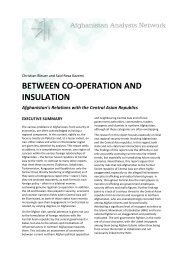Afghanistan in 2015 1
mM5Zmj
mM5Zmj
You also want an ePaper? Increase the reach of your titles
YUMPU automatically turns print PDFs into web optimized ePapers that Google loves.
8<br />
<strong>Afghanistan</strong> <strong>in</strong> <strong>2015</strong><br />
• Landm<strong>in</strong>es. Roughly one-third (33.8%) of Afghans say that landm<strong>in</strong>es or unexploded devices<br />
have caused accidents <strong>in</strong> their community at least several times a year. The highest frequencies of<br />
m<strong>in</strong>e- or unexploded device-related <strong>in</strong>cidents are <strong>in</strong> the South West and East regions.<br />
Economic growth and employment<br />
• Household f<strong>in</strong>ancial situation. More Afghans say that over the past year the f<strong>in</strong>ancial situation<br />
of their household has grown worse (29.7%), rather than better (21.0%); a rema<strong>in</strong><strong>in</strong>g 49.3% say<br />
their situation is unchanged.<br />
• Employment opportunities. More than half of respondents (55.4%) say that employment<br />
opportunities for their household are worse this year compared to last year, while 36.5% say<br />
they are the same, and 7.6% say they are better. Areas most affected <strong>in</strong>clude cities, particularly<br />
Kabul (73.6% report<strong>in</strong>g worsened job opportunities), where the number of higher-wage jobs<br />
have decreased, and <strong>in</strong> districts surround<strong>in</strong>g, supply<strong>in</strong>g, or contract<strong>in</strong>g from foreign military<br />
<strong>in</strong>stallations, particularly Balkh, Parwan, and Panjshir. Areas least affected <strong>in</strong>clude rural prov<strong>in</strong>ces<br />
with agriculture-based economies, such as Wardak and Laghman, but not <strong>in</strong> Helmand, Kandahar,<br />
and Farah, where poppy production decreased due to crop disease.<br />
• Availability of goods. Over one-third of Afghans (38.0%) say the availability of goods <strong>in</strong> their<br />
local market has decl<strong>in</strong>ed s<strong>in</strong>ce last year, consistent with reports of decreased trade with Pakistan<br />
<strong>in</strong> particular.<br />
• Assets. Half of respondents (53.7%) say they own land, and 82.3% say they have at least one<br />
mobile phone <strong>in</strong> their household. Rural and urban Afghans report hav<strong>in</strong>g different k<strong>in</strong>ds of assets,<br />
reflect<strong>in</strong>g different levels of access to electricity as well as different levels of exposure to markets.<br />
Compared to those liv<strong>in</strong>g <strong>in</strong> rural areas, urban Afghans are more likely to own consumer appliances<br />
such as a television, refrigerator, and wash<strong>in</strong>g mach<strong>in</strong>e. Rural Afghans are more likely to own land<br />
and livestock.<br />
Development and service delivery<br />
• Water. When asked about a range of public services, Afghans report the highest level of satisfaction<br />
(71.8%) with access to dr<strong>in</strong>k<strong>in</strong>g water, with rural and urban residents report<strong>in</strong>g satisfaction at<br />
similar rates. Most Afghans obta<strong>in</strong> their water from personal or communal wells, which have<br />
<strong>in</strong>creased <strong>in</strong> number nationwide. Satisfaction with irrigation water has decreased over time, which<br />
is of major concern, given that agriculture is the largest source of Afghan livelihoods and nutrition.<br />
• Electricity. Overall, 40.2% of respondents report satisfaction with electricity, with a major gap <strong>in</strong><br />
satisfaction between urban (73.4%) and rural (29.3%) residents. In the violence-affected South<br />
West and South East regions, a majority of Afghans say that, on average, access to electricity has<br />
grown worse over the past year (56.0% and 54.0% respectively). Kabul and Kunduz are the only<br />
two prov<strong>in</strong>ces where over 60% of Afghans report satisfaction with electricity.









